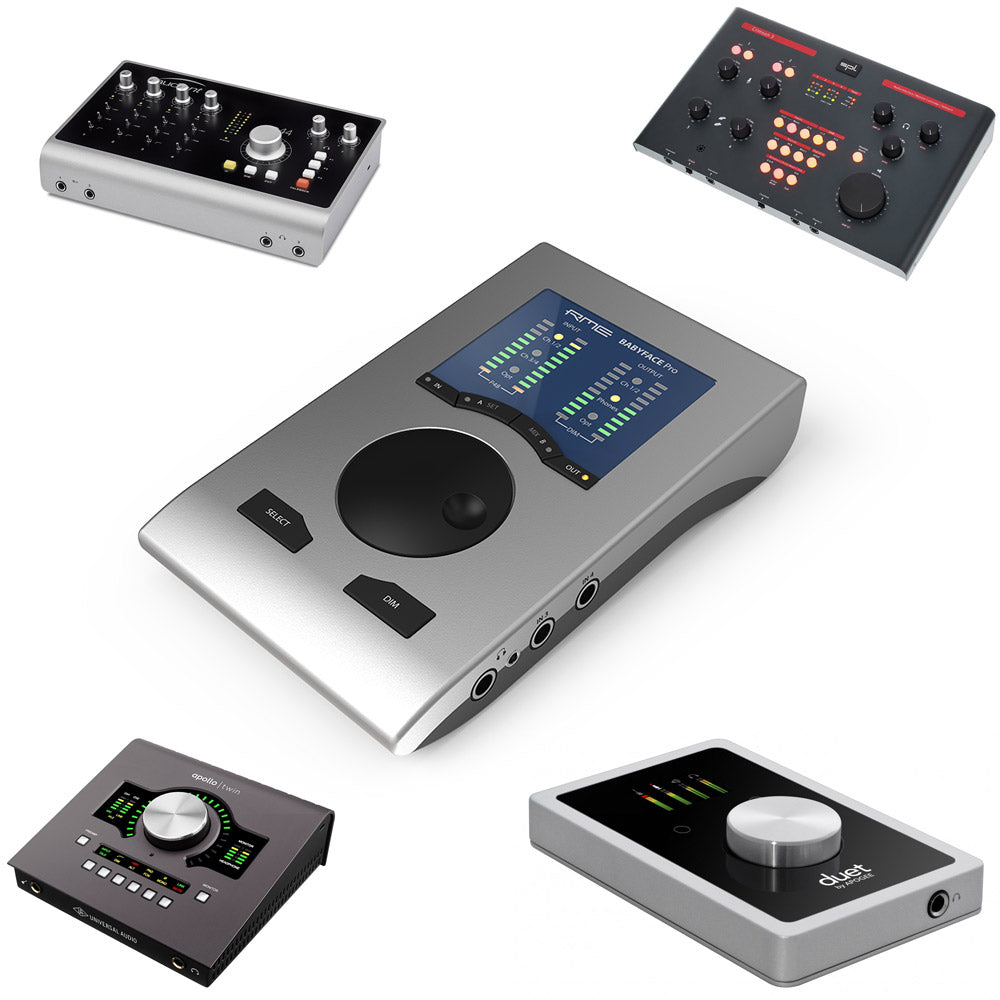
Ready to upgrade your audio interface? Perhaps you want better features, more I/O or chasing the next step up in audio quality.
Here's a run down of the 5 best mid tier audio interfaces available today.
RME Babyface Pro

The sleek brushed aluminium is a sight to behold on the desk second only to the Duet (Pictured below) in looks. The Babyface Pro provides a solid 4 input and 4 output as well as midi in / out
Easy access to main functions via the front panel 'big wheel' and select button to scroll though various options. Makes for a minimal though somewhat less efficient front panel.
Something else to note is RME's Totalmix software which amongst it's features allows you to tap into the Babyfaces FPGA-powered DSP mixer, meaning zero latency, zero CPU cost real time effects, accessible straight from the totalmix software mixer.
Lastly to note is RME's commitment to driver technology. Rather than relying on the base API for the device driver implementation RME write their own driver from the ground up. This translates to likely the lowest latency you'll get on a USB interface along with absolute driver stability.
SPL Crimson Mk3

The Crimson's layout looks distinctly busy compared to some of the devices on this article.
However this translates to instantaneous access to many features such as the independent line in volume, monitor mix, independent dual headphone amps and easy selection of input, output and audio DIM all confirmed by the no nonsense LED indicators.
It's got a whopping 16 Inputs, 6 independent recording channels, midi I/O and 2 speaker outputs.
The output and listening feature set starts to put this interface into dedicated monitor controller territory. Something to consider if you own more than one pair of monitors.
Also noteworthy is the "phonitor matrix" which aims to replicate a more realistic stereo field on the headphone output which could aid in more accurate headphone mixes.
Audio wise you'll not be left wanting, whilst we couldn't find readily available details on the DAC itself we can confirm the low-jitter fixed master clock and the option to use bit accurate driver along with solid component set meant audio quality was definitely up there with the rest of them.
Apogee Duet

Minimalist in design, this ultra clean looking interface was once the preserve of Mac users only. However in November 2017 Apogee made a leap and released Windows compatible drivers and software.
Complete with OLED display, this would win best looking interface at the drop of a hat, luckily it stands well amongst it's peers in terms of usability, functionality and sound quality.
Whilst slightly spartan on feature sets with a simple 2 Inputs, 4 outputs supplied via an included breakout cable it's audio quality is top drawer via the acclaimed ESS Sabre32 DAC and supports 24bit 192Khz sample rates running over the USB 2.0 infrastructure. It's a truly no nonsense interface that has a puritan-like approach to sound quality.
UA Apollo Twin MK2

Universal Audio - best known for it's hand built studio gear and DSP software has put it's experience, knowledge (and no doubt it's financial clout) together and come up with the Apollo twin.
Now on revision 2 it's a thunderbolt interfaced 2 in 6 out unit. Supporting an additional 8 input channels via optical in.
Aesthetically it stands between the SPL Crimson and the RME Babyface Pro meaning more accessible front panel functions but not the balls out knob per function like the SPL - somewhere in between.
UA state the unit has Uncompromising analog design, superior components, and premium build quality - Fortunately its not all marketing spiel, and the audio quality and build quality are indeed top notch.
Perhaps it's primary feature to many will be easy access into the fabled yet curious world of UAD plugins, with the twin available in SOLO, DUO and QUAD versions each with incremental steps up in DSP power.
Regardless of your thoughts of running software comprised of nothing but ZERO's and ONE's on hugely outdated SHARC chips under the hazy guise of "it runs on hardware so they must sound better" there's no doubt the UAD plugins do represent solid commitment to replicating their hardware counterparts with a few additional gems within the eco system too.
Audient ID44

Audient iD44 represents a massive 20 in 24 out interface within a sizeably boxy footprint.
Some standout features include an almost knob per function front panel, including 2 headphone outs each with independent control and dedicated DIM, talkback and cut control.
3 User function keys, and Audient's Scroll Control which transforms the main volume control into a DAW jog wheel along with other user definable selections at the click of a button.
Unlike the iD22 and iD14 before it the iD44 does not utilise Burr Brown converters, with no forthcoming info from Audient on what DAC's are used with Audient simply advising "After a lot of late nights here in office conducting listening tests, we found a great combo of other converters which sound great and improve on the sound of the iD22"
Needless to say Audient's commitment to audio quality again shines through and audio quality is indeed a step up from the iD22. Nothing less expected for a company with such pedigree in high quality studio gear, and the 22 delivers.
So next time you're asking yourself what's the best mid-range audio interface I can buy? Factor the 5 above into your purchasing decisions.

